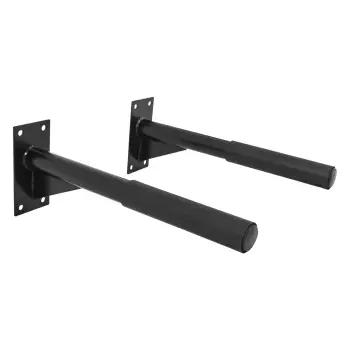Advantages of calisthenics parallel bars for functional training
Calisthenics structures are key allies for effective and comprehensive training. They allow simultaneous work on several muscle groups in a completely safe manner.
Among the most popular options in this regard are undoubtedly the calisthenics parallel bars. These are extremely versatile pieces of equipment that can be used both for free-body training and for targeted exercises such as dips for triceps, shoulders and chest.
The models available today, however, are not all the same. First of all, the parallel bars allow targeted training thanks to a stable and compact structure, ideal for every level of training, from beginners to advanced athletes.
Parallel bars, on the other hand, are an excellent choice for those who want to improve balance and coordination, thanks to the possibility of performing wide and controlled movements. Designed to be sturdy and reliable, they also prove essential in a professional gymnasium for a complete and safe workout.
With Donatif, you can take advantage of dozens of options, always safe in the knowledge that you can count on durable, certified equipment of the highest quality.
Free-body training with parallel bars for calisthenics and bodyweight
Free-body training with parallel bars for calisthenics and bodyweight offers an effective way to develop strength, endurance and balance using only your own weight. With these versatile structures, each exercise can be adapted to the athlete's level.
Perfect for complete and intense workouts, parallel bars prove to be an indispensable training tool for both calisthenics and fitness enthusiasts in general. Free-body training, after all, improves movement awareness and enables optimal physical condition.
Low parallel bars: ideal for beginners and advanced exercisers
The low parallel bars are the perfect equipment for those who want to approach calisthenics or consolidate their free-body training skills.
Thanks to their small size, they are particularly suitable for basic exercises such as push-ups, which allow strength and stability to be developed in a gradual and controlled manner.
More advanced athletes, however, can also find the low parallel bars a valuable support for complex exercises, such as the tuck planche or the L-sit, which require more control and endurance. They prove, in any case, to be a versatile and practical solution for everyday training.
Why choose high parallel bars for your training?
High parallel bars, on the other hand, are the ideal option when the goal is to increase strength and muscular endurance through more complex exercises.
They are distinguished by their greater height above the ground, a feature that allows for more movements, such as full dips, vertical push-ups and various isometric exercises.
High parallel bars are particularly popular for both calisthenics and functional fitness training, as they allow intensive training of arms, shoulders, back and core.
Thanks to their stability, they are perfect for those who want to perform wide, controlled movements, progressively increasing the difficulty and reaching an advanced level of strength and coordination.
Self-supporting parallel bars for calisthenics: main features
More versatile and practical, however, are the free-standing parallel bars, because they offer the opportunity to train without the need for fixed anchors. These structures, not surprisingly, are designed to provide maximum stability while performing exercises, even in the case of complex movements.
Easy to position and move, self-supporting parallel bars adapt to any training space, from the most compact home gym to professional gyms. While their robustness guarantees safety and durability, even during intense workouts.
Calisthenics parallel bars online at Donatif.com
Buying calisthenics parallel bars online at Donatif.com means choosing high quality equipment, made for excellent performance and durability. Our selection includes models ideal for any training need, from beginners to advanced athletes, with customisable options and fast shipping.
Every product in our offering, after all, is designed to support improved performance.
Things to know about calisthenics parallel bars
What do you train with parallel bars?
With the parallel bars you train mainly the chest, triceps, shoulder and core muscles. Exercises such as dips and planche are effective for developing strength and stability in the upper body.
How wide are the parallel bars?
Parallel bars are generally between 50 and 60 cm wide, an ideal distance to allow a comfortable and secure grip during exercises.
How high are the parallel bars?
Parallel bars are usually between 100 and 130 cm high to allow full and safe movement during training, also for exercises such as dips and handstand.
What are the parallel bars used for?
Parallel bars are used to perform strength exercises involving the muscles of the upper body, such as dips, L-sits and planks. They are ideal for improving stability, control and muscular endurance.
What are low parallel bars used for?
Low parallel bars are used for low-impact exercises such as push-ups, dips and plank variations. They are used to improve core and upper body strength, offering stability and safety.


